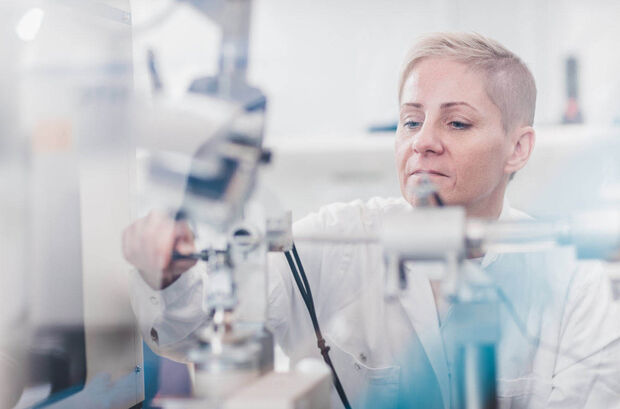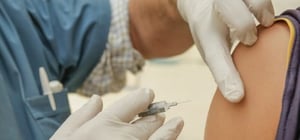AstraZeneca PLC (LON:AZN), today announced full year results for the Q4 2018.
The final quarter of the year saw a very strong performance, including Product Sales growth of 5% (8% at CER1) to $5,768m. In the year, Product Sales increased by 4% to $21,049m, reflecting the performance of new medicines2 (+81%) and the sustained strength of Emerging Markets (+12%, +13% at CER); China sales increased by 28% (25% at CER) in the year. Oncology sales increased by 50% (49% at CER) in FY 2018, with Tagrisso and Lynparza each doubling in sales, accompanied by a promising performance from Imfinzi. Fasenra sales reached $297m in its first full year, performing exceptionally well in the countries where it was launched.
In addition, Earnings Per Share (EPS) benefited from a low tax rate. The pipeline produced further positive developments and 2019 is expected to be another busy year for news flow.
|
FY 2018 |
Q4 2018 |
|||||
|
$m |
% change |
$m |
% change |
|||
|
Actual |
CER |
Actual |
CER |
|||
|
Product Sales |
21,049 |
4 |
4 |
5,768 |
5 |
8 |
|
Externalisation Revenue |
1,041 |
(55) |
(55) |
649 |
n/m |
n/m |
|
Total Revenue |
22,090 |
(2) |
(2) |
6,417 |
11 |
14 |
|
Reported Operating Profit3 |
3,387 |
(8) |
(7) |
1,077 |
57 |
54 |
|
Core Operating Profit4 |
5,672 |
(17) |
(17) |
2,192 |
23 |
23 |
|
Reported Earnings Per Share (EPS) |
$1.70 |
(28) |
(29) |
$0.82 |
(21) |
(22) |
|
Core EPS |
$3.46 |
(19) |
(19) |
$1.58 |
22 |
22 |
Pascal Soriot, Chief Executive Officer, commenting on the results said:
“Closing the year with another strong quarter, our performance confirmed that AstraZeneca has returned to growth. Our new medicines performed particularly well across the therapy areas and the Emerging Markets business went from strength to strength. 2019 will be a year of focus on continued pipeline delivery and flawless commercial execution. The performance of our new medicines demonstrated the ability of our commercial teams to convert the pipeline into successful medicines.
As we recently entered a new phase in our strategic development, we have refined our organisation to position ourselves for the next phase of our journey. The changes are designed to further integrate research and development and accelerate decision-making and the launches of new medicines, consolidating what we believe is already one of the most exciting and productive pipelines in the industry. We are also enhancing our commercial units to increase collaboration with our R&D organisation, enabling greater commitment to our main therapy areas; we want AstraZeneca to be more agile, collaborative and focused as we enter a period of sustained growth.
Our strategy and plans remain unchanged, with sales growth and a focus on cost management anticipated to drive growing operating profit. I’m pleased that we are fully on track to meet these commitments as we build a sustainable level of growth and a pipeline that is benefitting more and more patients around the world.”
Financial summary
– Product Sales increased by 4% in the year to $21,049m; new medicines generated incremental sales of $2.8bn at CER. Total Revenue declined by 2% in the year to $22,090m, driven by a 55% decline in Externalisation Revenue to $1,041m, with the year-on-year performance partly reflecting the impact of $997m of Initial Externalisation Revenue recognised in FY 2017 as part of the Lynparza collaboration with MSD5
– The Reported Gross Margin declined by three percentage points to 77% in the year, partly reflecting restructuring charges associated with biologic-medicine manufacturing facilities, the comparative effect of manufacturing variances in the first half of 2017 and the impact of the Lynparza collaboration with MSD; the Core Gross Margin declined by two percentage points to 80%
– Total Reported Operating Expenses of $16,294m were stable in the year (a decline of 1% at CER). Total Core Operating Expenses increased by 5% (4% at CER) to $14,248m:
– Reported R&D Expenses, which increased by 3% in the year to $5,932m, contained Intangible Asset Impairment charges of $539m (FY 2017: $101m), including a $470m charge in respect of MEDI0680. Core R&D Expenses declined by 3% to $5,266m, driven by efficiency savings and resource optimisation
– Reported SG&A Expenses declined by 2% in the year (3% at CER) to $10,031m; Core SG&A Expenses increased by 10% (9% at CER) to $8,651m, reflecting support for new medicines and growth in China
– Reported Other Operating Income and Expense increased by 38% to $2,527m, reflecting divestment transactions, while Core Other Operating Income and Expense increased by 10% in the year to $2,147m. The difference between the Reported and Core performances was represented by a legal settlement in the first half of the year
– As indicated, restructuring expenses declined to $697m in the year (FY 2017: $807m). Designed to drive further efficiencies in the operations network, the Company recently decided to close two biologic-medicine manufacturing sites in Colorado, US. Associated with the closures, the Company expects to incur $0.4bn of one-time restructuring charges, the majority of which would be non-cash expenses; $0.3bn of these charges were recognised in FY 2018 as a result of impairments of site-related assets and inventory
– As indicated, capital expenditure declined to $1,043m (FY 2017: $1,326m)
– Reported EPS of $1.70 in the year represented a decline of 28% (29% at CER). Both Reported and Core EPS were impacted primarily by a decline in Externalisation Revenue, as well as the Gross Margin
– Core EPS declined by 19% to $3.46, despite a favourable impact resulting from a lower Core Tax Rate of 11% reflecting a $245m favourable adjustment to deferred taxes arising from the recently-announced reduction in the Dutch corporate income-tax rate; enacted in December 2018, it equated to $0.19 per share. Milestone revenue of $70m from MSD that related to the rapid regulatory approval in the US of Lynparza as a 1st-line maintenance treatment for BRCA-mutated (BRCAm) advanced ovarian cancer was received earlier than anticipated
– The Board has reaffirmed its commitment to the progressive dividend policy; a second interim dividend of $1.90 per share has been declared post year end, taking the unchanged full-year dividend per share to $2.80
Commercial summary
– Oncology
Sales growth of 50% in the year (49% at CER) to $6,028m, including:
– Tagrisso sales of $1,860m, representing growth of 95% (93% at CER), with increased use as a 2nd-line treatment for EGFR6 T790M-mutated7 NSCLC8 patients and the 2018 approvals in the 1st-line EGFR-mutated (EGFRm) setting as a new standard of care (SoC). Tagrisso, based on the performance in FY 2018, is anticipated to be AstraZeneca’s biggest-selling medicine in 2019
– Imfinzi sales of $633m (FY 2017: $19m), reflecting ongoing launches for the treatment of patients with unresectable, Stage III NSCLC. The majority of sales of Imfinzi were in the US; the favourable impact of additional potential launches in other markets is yet to come
– Lynparza sales of $647m, representing growth of 118% (116% at CER), driven by expanded use in the treatment of ovarian cancer and the medicine’s first approvals for use in the treatment of breast cancer. The recent approval of Lynparza as a 1st-line treatment of patients with BRCAm ovarian cancer in the US is expected to support further expanded use
– New CVRM9
Sales growth of 12% in the year to $4,004m, including:
– Farxiga sales of $1,391m, with growth of 30% that included a sales increase of 45% in Emerging Markets (52% at CER) to $336m
– Bydureon sales of $584m, an increase of 2% (1% at CER) that was driven by an encouraging Bydureon BCise launch in the US. Total Q4 2018 sales declined by 6% (5% at CER) to $138m, reflecting ongoing production constraints
– Brilinta sales of $1,321m, representing growth of 22% (21% at CER), due to continued market penetration in the treatment of acute coronary syndrome and high-risk post-myocardial infarction (HRPMI). Total Brilinta sales increased by 26% in Q4 2018 (29% at CER) to $376m
– Respiratory
Sales growth of 4% in the year (3% at CER) to $4,911m, including:
– A Symbicort sales decline of 9% (10% at CER) to $2,561m, as competitive price pressures in the US continued, despite a market-share increase for the medicine. China sales of Symbicort increased by 36% (32% at CER) to $240m
– Pulmicort sales growth of 9% (8% at CER) to $1,286m
– Fasenra sales of $297m (Q4 2018: $125m), consolidating its position in the IL-5 class of severe-asthma medicines, performing exceptionally well in the countries where it was launched
– Emerging Markets
The Company’s largest region by Product Sales, with growth of 12% in the year (13% at CER) to $6,891m, including:
– A China sales increase of 28% (25% at CER) to $3,795m. Q4 2018 sales in China increased by 17% (22% at CER) to $948m, despite Q4 2017 year-on-year growth of 33% (30% at CER). Oncology sales in China increased by 44% in the year (41% at CER) to $810m, partly underpinned by the launch of Tagrisso in China in 2017. Tagrisso was recently added to the National Reimbursement Drug List (NRDL) for the treatment of 2nd-line EGFR T790M-mutated NSCLC
– An ex-China sales decline of 3% (an increase of 1% at CER) to $3,096m, partly impacted by the loss of Product Sales as a result of divestments. The quarter, however, saw a significantly-improved performance as the impact of divestments diminished, with every Emerging Markets sub-region delivering growth at CER and total ex-China Emerging Markets stable sales of $818m (an increase of 10% at CER). Notable performances in the quarter included sales in Brazil (stable, +23% at CER) and (non-China) Asia-Pacific (+10%, +13% at CER)
Organisational changes
As AstraZeneca recently entered a new phase in its strategic development, the Company announced in January 2019 organisational changes to enhance scientific innovation and commercial success.
The new structure simplifies R&D functions from discovery to late-stage development into Oncology and BioPharmaceuticals, or BioPharma. The new Oncology R&D function will be led by a world-renowned expert in the field, José Baselga and the BioPharma R&D function will be led by Mene Pangalos, who was previously responsible for the Company’s Innovative Medicines and Early Development Biotech Unit.
The same approach has been applied to the majority of the Company’s commercial operations. The commercial function for Oncology will continue to be led by Dave Fredrickson and the commercial function for BioPharma will be led by Ruud Dobber, most recently responsible for the Company’s commercial operations in North America. The Emerging Markets commercial function remains under the leadership of Leon Wang.
The goals of the reorganisation are to:
– Further increase focus on the Company’s main therapy areas
– Integrate R&D functions for agile decision making and more flexible resource allocation
– Increase collaboration between the R&D and commercial functions
The R&D and commercial functions will each be represented on the Senior Executive Team of AstraZeneca and report to Chief Executive Officer (CEO), Pascal Soriot. The functions will share many common areas including basic biology and science platforms as well as medicine supply, manufacturing and IT infrastructure to improve efficiency. These resources will continue to be allocated on a Company-wide basis, according to the overall therapy-area considerations and strategy.
As AstraZeneca entered a period of sustained growth, the reorganisation was designed to enable the Company to be more agile, collaborative and be very focused on the main therapy areas. Further details of the changes can be found in the Corporate & Business Development section.
Pipeline highlights
The following table highlights significant developments in the late-stage pipeline since the prior results announcement:
|
Regulatory approvals |
– Lynparza – ovarian cancer (1st line) (SOLO-1): regulatory approval (US) – roxadustat – anaemia in dialysis patients: regulatory approval (CN) – Bevespi – COPD10: regulatory approval (EU) – Linzess (linaclotide) – inflammatory bowel syndrome w/constipation (IBS-C): regulatory approval (CN) |
|
Regulatory submissions and/or acceptances |
– Imfinzi – unresectable, Stage III NSCLC: regulatory submission (CN); acceptance (OS11 data) (US) – Farxiga – type-1 diabetes: regulatory submission acceptance (US) – Fasenra – severe, eosinophilic asthma; self-administration: submission acceptance (US, EU) |
|
Major Phase III data readouts or other significant developments |
– Tagrisso – EGFRm NSCLC (1st line): priority review (CN) – Imfinzi +/- treme – NSCLC (1st line) (MYSTIC): did not meet OS primary endpoints – Imfinzi +/- treme – head & neck cancer (2nd line): did not meet OS primary endpoints – Lynparza – ovarian cancer (1st line) (SOLO-1): priority review (CN) – Lynparza – ovarian cancer (3rd line+): met response rate primary endpoint – Forxiga – type-1 diabetes: CHMP12 positive opinion (EU) – roxadustat – anaemia of CKD13: met primary efficacy endpoints – Fasenra – eosinophilic granulomatosis with polyangiitis: Orphan Drug Designation (US) – Fasenra – hypereosinophilic syndrome: Orphan Drug Designation (US) – PT010 – COPD: priority review (CN) – MEDI8897- lower respiratory tract infection: Breakthrough Therapy Designation (US), PRIME14 designation (EU) |









































